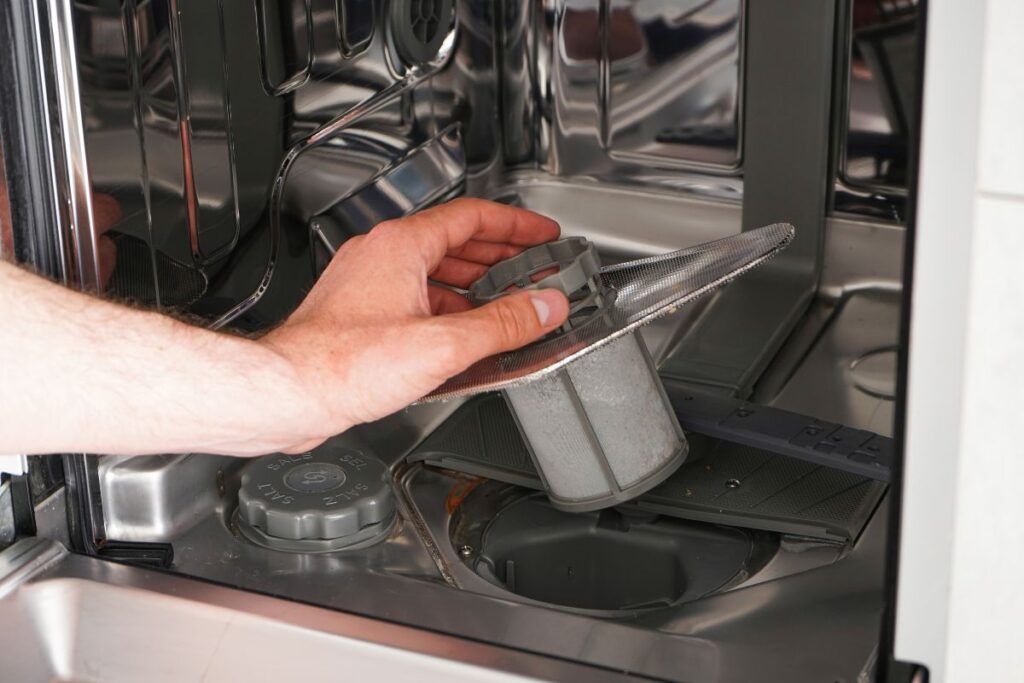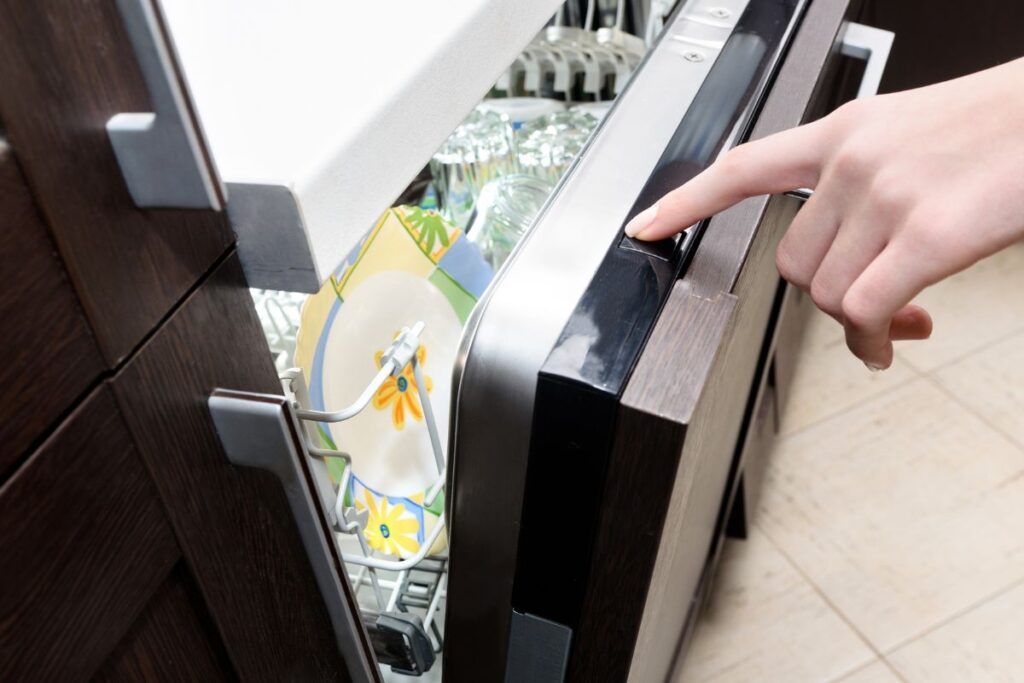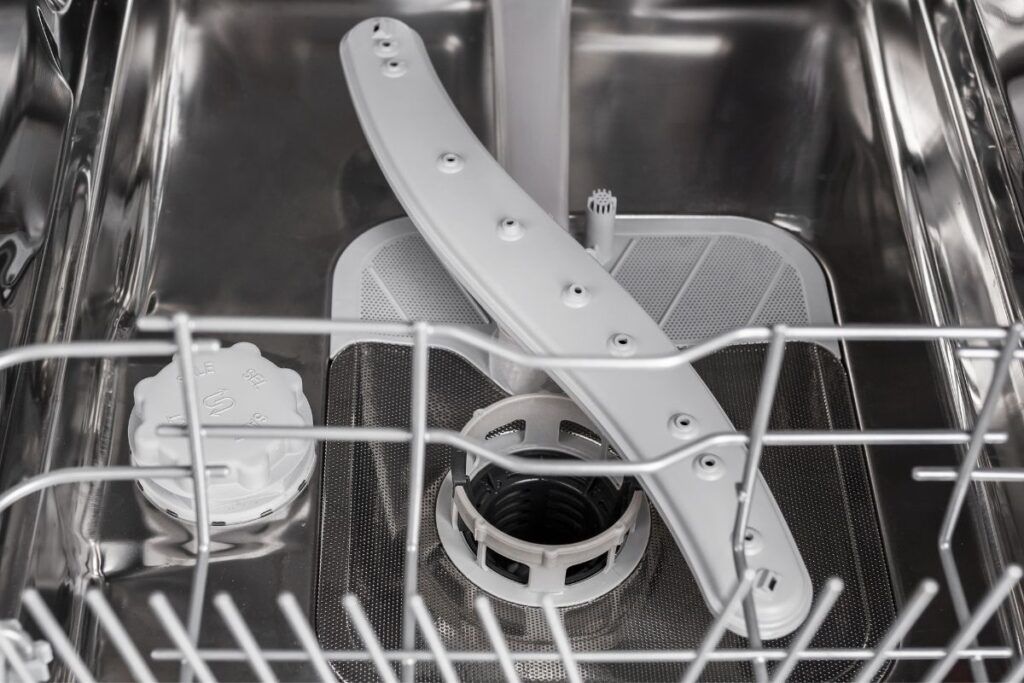Cooking fresh food at home is healthy and fine until the greasy dishes come into the picture. Fortunately, dishwashers are there to rescue you from the daunting experience. But what to do if your Amana dishwasher is not draining?
I faced this issue quite a few times when my dishwasher stopped draining, and I know this is not uncommon. So, I am going to share my findings with you today.
If your Amana dishwasher is not draining water, start by checking the basic things, like whether you closed the door properly or turned off the switchboard. If these are not the issue, check the drainage connections, the solenoid, or the drain valve. If nothing seems wrong, check the motor.
In this article, we will understand all the possible reasons behind your Amana dishwasher not draining and how you can deal with each of them. So, keep reading.

Check out our list of top-handpicked products for all your electrical, appliance, and HVAC system needs to keep your home running smoothly.
This post includes some affiliate links.Why is your Amana dishwasher not draining?
I have faced situations where my dishwasher stopped draining, but I could identify and fix the issue myself.
But before inspecting the reason for the issue, manually drain the stagnant, smelly water.
It will be helpful to figure out the reason for water not draining out of your dishwasher.
The mistake that led to my dishwasher not draining was that I did not close the door properly.
And another time, the drainage hose was clogged, but I could fix that, which I have explained in the respective point.
Now, let’s understand the possible problems.
1. The drainage connections are not working
The method of fixing the issue varies based on the type of drainage connection.
Therefore, it is crucial to understand the type of connection you have used to connect your dishwasher with drainage.
Here are the three common types of connections:
- Connection to garbage: In this type of connection, the dishwasher drain hose will enter the kitchen cabinet, which is tied with a chain to connect the hose to the garbage.
- Connection to drain pipe: If it is not connected to the garbage disposal, it goes through the cabinet to connect with the drain pipe.
- Air gap disposal connection: This connection follows the same method as the garbage disposal connection but does not connect the hose with a chain. Instead, it fits at the lateral side of the sink. On the lateral side, there will be an air gap where you will fix the cylinder knob to promote the easy flow of air to get rid of sink water.
After you’ve figured out the connection type, it is time to identify the problem.
Clogged garbage disposal
Stuck food materials can block the water flow.
In such cases, you can use these three methods to fix this:
- You can use lights to see what is making the pipe clog. After confirming, you can use tongs to remove the materials causing the clog.
- Mix vinegar and baking soda to remove the strong and greasy substances. After putting this mixture, wait for 15 minutes to see the result.
- Using a plunger will fasten the process. Move the plunger vigorously to remove the clog completely.
This will solve the issue if your dishwasher is not draining out because of any of these.
Drain disposal pipe issue
The continuous usage of the dishwasher without proper maintenance can cause the drain disposal pipe to get blocked with greasy and salty materials.
Drainage disposal issues can be the common reason.
To solve this, remove the hose completely and run water through it.
Attach it back and check if your dishwasher is draining.
If not, there must be some other problem.
Faulty air gap disposal
This issue won’t occur frequently.
Check the air gap to check for any dirt deposition.
If you find any blockage, run water through it and repeat the cycle.
You can also remove the clog with vacuum pressure.
To do this, use your dry vacuum and make sure the hose is fixed on the end outlet air.
Now turn on the vacuum after filling your sink with hot water.
This force will remove the clog.
2. Solenoid fault
A solenoid is an important part of the dishwasher that enables the opening of the water draining valve.
If a solenoid works well, the water drains and fills without hassle.
If it doesn’t work, there will be a problem with water draining out.
Use the manual to locate the solenoid and inspect it thoroughly to find signs of damage.
Consult the technician to replace the solenoid if you find an issue with this.
Make sure the new solenoid is purchased from a good company.
3. You are not closing the dishwasher door properly

If you do not close the door before draining, the dishwasher will get struck.
Thus, incomplete draining of water will happen.
Close the door completely and switch on the dishwasher.
4. Drain valve issue
Sometimes, drain valves may get struck, not allowing the water to drain.
You can find the valve at the bottom of your dishwasher.
Once you locate it, inspect it thoroughly.
The drain valve of your dishwasher is in bad condition if:
- It is leaking.
- It takes too much time for your dishwasher to fill.
- Water leakage on your kitchen floor.
- It’s not opening.
If it is dirty, wash and clean it.
If the water still doesn’t drain, you must replace it with the new one.
5. Drain impeller fault
A drain impeller is located at the bottom of the dishwasher.
It allows the water to drain out through the drainage hose.
Once you locate the impeller, try to look for damages.
If you find any, replace it with a new one.
6. Stuck check ball
You can find the check ball attached to the check valve.
It prevents the water from returning to the dishwasher after it is drained.
Sometimes, it may get stuck, and water may come back to the dishwasher.
Find the check ball and check if it’s stuck.
If it is, you need to repair or replace it.
If this is the cause of the problem, water will drain out.
7. Electric source
Dishwashers are commonly connected to the electric board.
When the electric switch is turned off accidentally in the middle of the cycle, water will not drain out.
Make sure of the continuous supply of electricity throughout the process.
8. Motor fault
It may be the major issue of water not draining out.
A faulty motor will not run during the water draining cycle.
You may need the assistance of a plumber in such cases.
This fault requires a complete replacement of the motor.
9. Clogged drainage hose

The pipe which takes the drained water out of the dishwasher is called the drain hose.
If this is blocked, water may get stuck in between.
You can solve this minor issue without the hindrance of day-to-day activities.
It is as simple as removing the hose pipe from both ends and running hot water through it to remove any blockage.
Attach it back and check if the water drains.
10. Drain pump issue
You can find a drain pump at the bottom of the dishwasher.
Turn the dishwasher off and test it with a multimeter.
If it proves inefficient and doesn’t show continuity upon testing, it’s better to replace it.
If that’s the issue, water should drain after replacement.
11. Incomplete cycle
Water won’t drain out in case of a non-continuous cycle.
Find the restart button in the dishwasher to start the new cycle.
If water was stagnant due to the incomplete cycle, you could solve this issue by restarting the dishwasher.
12. Using regular detergent

You can’t compromise when it comes to the detergent of the dishwasher.
It is recommended to use automated dishwasher liquids.
If regular detergent is used, it will hamper the dishwasher’s efficiency and cause problems.
Also, if you add detergent directly into the dishwasher, it will cause suds and prevent drainage.
13. Standing water
The Amana dishwasher will have a filter area.
If you notice standing water in this area, you must fix it.
The water in this area is supposed to drain as soon as the cleaning cycle begins.
If that doesn’t happen, the water will not drain out.
If you notice this problem, clear the filter area.
How can we drain the Amana dishwasher manually?
Whether you need help from the plumber or need to fix the issue yourself, the first thing you will want to do is drain the dishwasher manually.
Once the water is out, you can then continue fixing the issue.
Here is a step-by-step process on how to drain the Amana dishwasher manually.
1. Turn the dishwasher off
Turn off the dishwasher before you drain it manually.
Ensure there is no electric connection between the dishwasher and the garbage disposal.
Since the dishwasher has water, keeping the electricity connected will not be safe.
2. Empty the dishwasher
The first thing you must do is empty the dishwasher.
Take out all the dishes first.
If you have dirty dishes, you can clean them after fixing the dishwasher.
Also, remove the bottom rack for better access to all the parts.
3. Remove the water
Now, use a towel to remove all the standing water.
This will help you troubleshoot the dishwasher without any hazards of water falling on the ground.
Another way to go about it is:
- Mix 1/2 cup of water with 1/2 cup of baking soda.
- Now, pour this mixture into the drain line.
- Now pour 1/2 cup vinegar into the drain line.
- Leave this for 10-15 minutes.
- After that, pour hot water into the drain line.
This should help you drain the stagnant water.
How to maintain the Amana dishwasher?
A dishwasher is like any other machine which needs proper maintenance and care to improve its longevity.
Here is how you can maintain your Amana dishwasher:
Exterior cleaning
Using a cotton cloth is recommended to clean the dishwasher’s exterior body.
Using mild detergent will give your dishwasher a shiny look.
If your dishwasher comprises a stainless steel body, it’s better to use stainless steel cleaner than a detergent.
Avoid harsh handling of your dishwasher to improve its functionality.
Interior cleaning
It’s important to clean the interiors of Amana dishwashers because hard water minerals can deposit and cause harm to your dishwasher.
You can use dishwashing powders or liquid detergents by putting them in a smooth sponge to clean the interiors of the dishwasher.
You can use vinegar to remove stubborn dirt and spots.
However, vinegar is an acid.
Using it too often will damage your dishwasher.
Maintenance procedure
It’s essential to install a water softener.
If it is not installed, it’s recommended to use a fresh dishwasher cleaner.
It will remove the dirt and stubborn spots.
- Use it at least once a week: Please don’t keep it unused for a long period. It’s better to use it at least once a week to maintain the motor’s efficiency.
- Turn off while not in use: You may not use it for a long time while on vacation. During those times, make sure to cut the water and power supply. During winter, ensure your water supply pipelines are prevented from freezing. In such cases, your dishwasher may get damaged.
- Clean your dishwasher’s filter: A clogged filter can cause the blockage of water, thus resulting in water stagnation. Remove the filter, clean it with mild detergent, and throw away the clogs.
How to deep clean the Amana dishwasher?

As mentioned, maintaining a dishwasher is essential to increase efficiency.
In this part, let’s understand how to deep clean the Amana dishwasher.
- Remove all the holders, filters, and dishwasher racks to enhance deep cleaning.
- After removing them, soak them in hot water.
- Check all the corners of the dishwasher to remove dirt and strong deposition.
- You can use a toothbrush to remove the dirt hidden in the corners.
- Vinegar treatment is the best solution to deep clean the dishwasher. Fill a bowl with vinegar and place it on the downside of the dishwasher. Run your dishwasher in the hot water cycle.
- The next step is to use baking soda. Run the wash cycle for the second time with the mixture of baking soda. This step will give your dishwasher a fresh look. Following this process makes your dishwasher smell good.
- Check your dishwasher temperature. Make sure it is between 120-150°F.
Why is it important to clean your Amana dishwasher?
Cleaning your Amana dishwasher is important.
Finding fault with the drainage might not be unusual if you don’t do it.
- If you don’t clean your dishwasher, it will spread a bad smell throughout the kitchen. It is because the remaining food will start to decompose, and microbes will grow.
- Food will stay in the filter, and while your dishwasher is recycling the water, those food particles will hit back at your dishes.
- If you are not cleaning your dishwasher for long, food particles will clog the filters, and the whole machine will stop working.
- A malfunctioning dishwasher will force you to wash dishes manually, hindering your day-to-day activities.
- The rubber material which keeps the grip of opening and closing the machine will get greasy with mold formation.
- There will be the development of rust around the doors of the dishwasher.
It’s better to keep your dishwasher clean than to face all these troubles because the dishwasher is there to save and not ruin your time.
If you maintain the cleanliness of the dishwasher, you can enjoy all the benefits of the dishwasher.
Final thoughts
If your Amana dishwasher doesn’t drain out the water, it can be resolved with a simple step in most cases. You need to check the different parts of the dishwasher, as I mentioned, and fix the issue as soon as you identify it.
If you still can’t solve the draining issue of your Amana dishwasher yourself or find a problem that requires expert help, call the plumber to solve this issue efficiently.
Don’t forget to clean your Amana dishwasher from time to time to avoid unnecessary problems that prevent drainage.
Reference: Amana Official Troubleshooting

